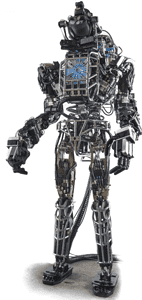
What’s possibly the most advanced humanoid robot ever built was recently unveiled by Boston Dynamics – one of the most impressive and renowned robotics company. Named ATLAS, this 6′ 2 tall, 330-pounds powerhouse has all the agility and strength of the Petman, only this time it also has a head. Mounted inside the head are a LIDAR sensor (measures distance with a laser, as in Google’s self-driving car), stereo vision systems and an on-board real-time control computer. It still does not have a functioning ‘brain’ though.
This task will be reserved to one of the seven teams invited last week at the Boston Dynamics headquarters, selected from a list of participants at DARPA’s Virtual Robotics Challenge (VRC). The winning team will be the one which develops the best software that will help ATLAS perform its main mission: help the military perform rescue operations in situations where humans cannot survive, such as a Fukushima Daiichi power plant. This is no easy task however. ATLAS will require a control unit, that will guide the complex suite of sensors, actuators, joints, and limbs that make up the robot. The teams have until late December 2013 to teach ATLAS the moves it will need to succeed in the DARPA Robotics Challenge (DRC) Trials and the winning team will bag a $2 million prize.
Was this helpful?



